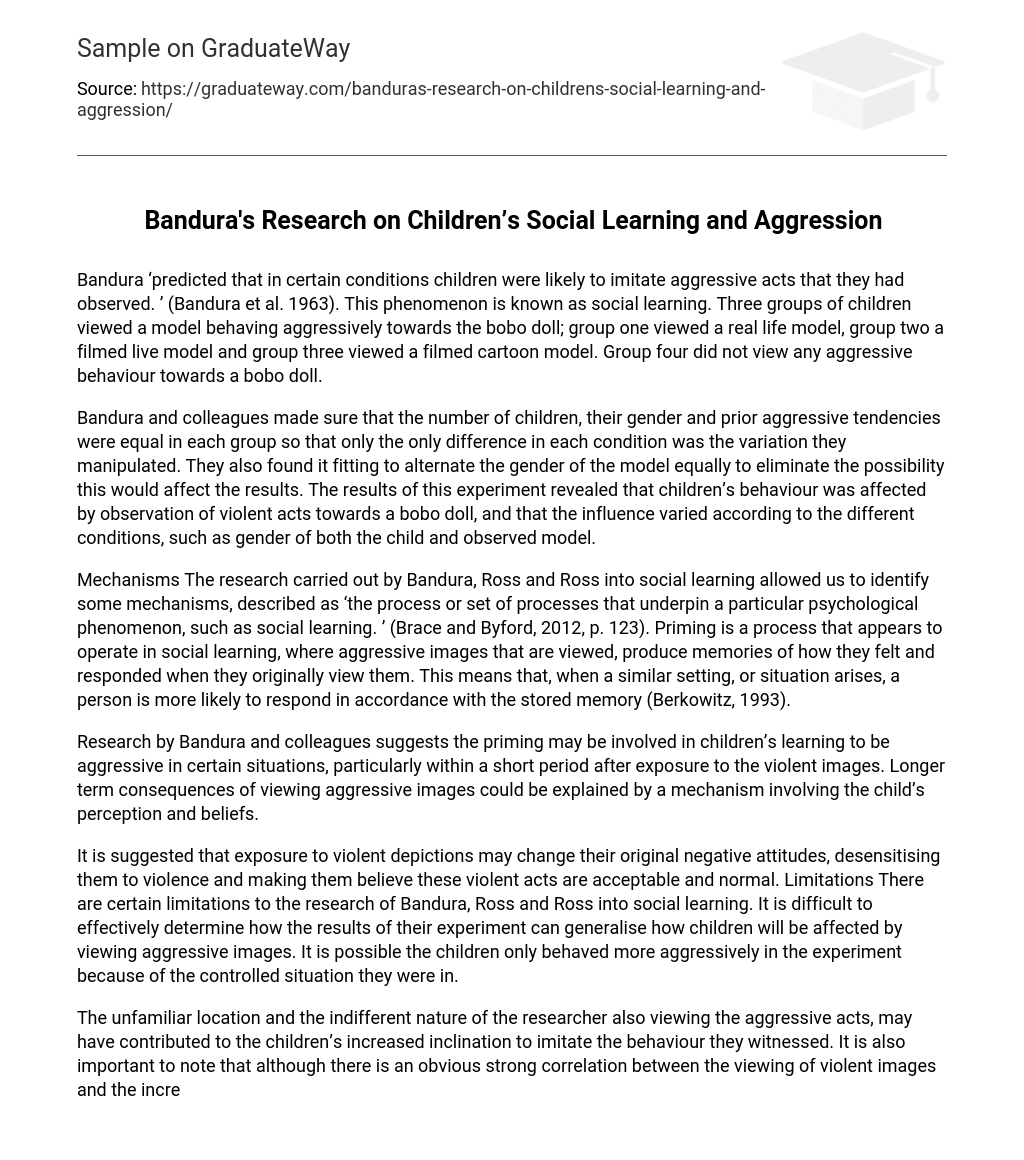Bandura ‘predicted that in certain conditions children were likely to imitate aggressive acts that they had observed. ’ (Bandura et al. 1963). This phenomenon is known as social learning. Three groups of children viewed a model behaving aggressively towards the bobo doll; group one viewed a real life model, group two a filmed live model and group three viewed a filmed cartoon model. Group four did not view any aggressive behaviour towards a bobo doll.
Bandura and colleagues made sure that the number of children, their gender and prior aggressive tendencies were equal in each group so that only the only difference in each condition was the variation they manipulated. They also found it fitting to alternate the gender of the model equally to eliminate the possibility this would affect the results. The results of this experiment revealed that children’s behaviour was affected by observation of violent acts towards a bobo doll, and that the influence varied according to the different conditions, such as gender of both the child and observed model.
Mechanisms The research carried out by Bandura, Ross and Ross into social learning allowed us to identify some mechanisms, described as ‘the process or set of processes that underpin a particular psychological phenomenon, such as social learning. ’ (Brace and Byford, 2012, p. 123). Priming is a process that appears to operate in social learning, where aggressive images that are viewed, produce memories of how they felt and responded when they originally view them. This means that, when a similar setting, or situation arises, a person is more likely to respond in accordance with the stored memory (Berkowitz, 1993).
Research by Bandura and colleagues suggests the priming may be involved in children’s learning to be aggressive in certain situations, particularly within a short period after exposure to the violent images. Longer term consequences of viewing aggressive images could be explained by a mechanism involving the child’s perception and beliefs.
It is suggested that exposure to violent depictions may change their original negative attitudes, desensitising them to violence and making them believe these violent acts are acceptable and normal. Limitations There are certain limitations to the research of Bandura, Ross and Ross into social learning. It is difficult to effectively determine how the results of their experiment can generalise how children will be affected by viewing aggressive images. It is possible the children only behaved more aggressively in the experiment because of the controlled situation they were in.
The unfamiliar location and the indifferent nature of the researcher also viewing the aggressive acts, may have contributed to the children’s increased inclination to imitate the behaviour they witnessed. It is also important to note that although there is an obvious strong correlation between the viewing of violent images and the increased aggressive acts performed by children, this does not prove that one causes the other. It is extremely difficult to establish a direction of effect; to prove that witnessing violent material causes children to perform more violent acts than if they hadn’t witnessed previous violent media.
It is equally possible that children that possess a prior inclination to perform aggressive acts are significantly more likely to want to view violent material. The research of Bandura, Ross and Ross on social learning and aggression does not address this. Relevance to modern day The research conducted by Bandura, Ross and Ross had lasting impact on how we understand children’s behaviour. Certainly the Bobo doll experiment had its limitations, however the results obtained are the foundation for all subsequent research on social learning and our understanding of children’s behaviour.
Although the degree to which the findings can generalise with normal day situations outside the laboratory, there is no denying that viewing violent images has a lasting effect on the mind of a child. In today’s modern world where violent material is more widely available, Bandura and colleague’s research has become ever more relevant in understanding how children’s behaviour is affected by this increased exposure. Conclusion The research carried out by Bandura, Ross and Ross on social learning and aggression has considerably helped our understanding of children’s behaviour. Although there are a few limitations to their experiments, it has undoubtedly contributed to our understanding of the role social learning plays in developing a child’s behaviour.





